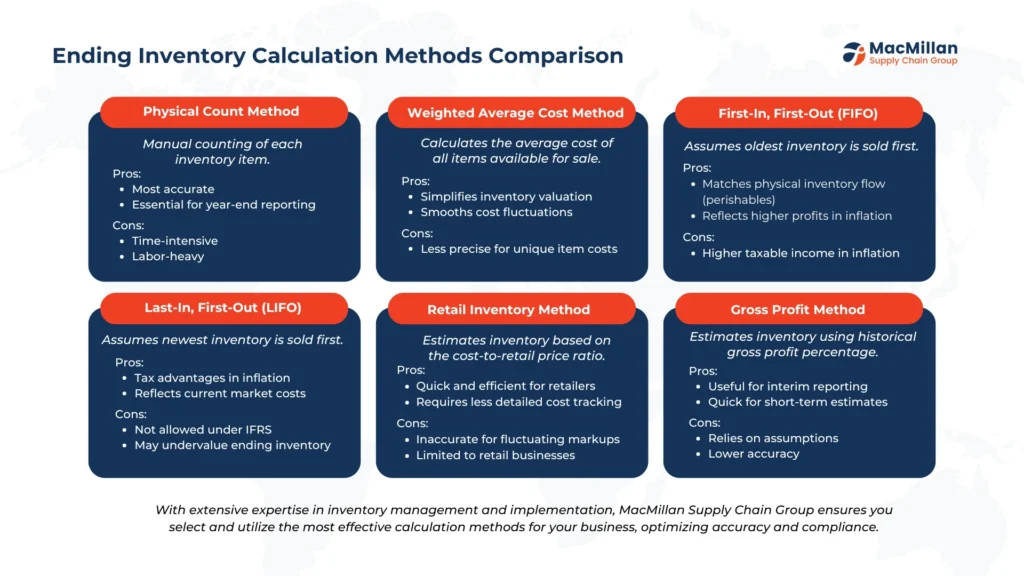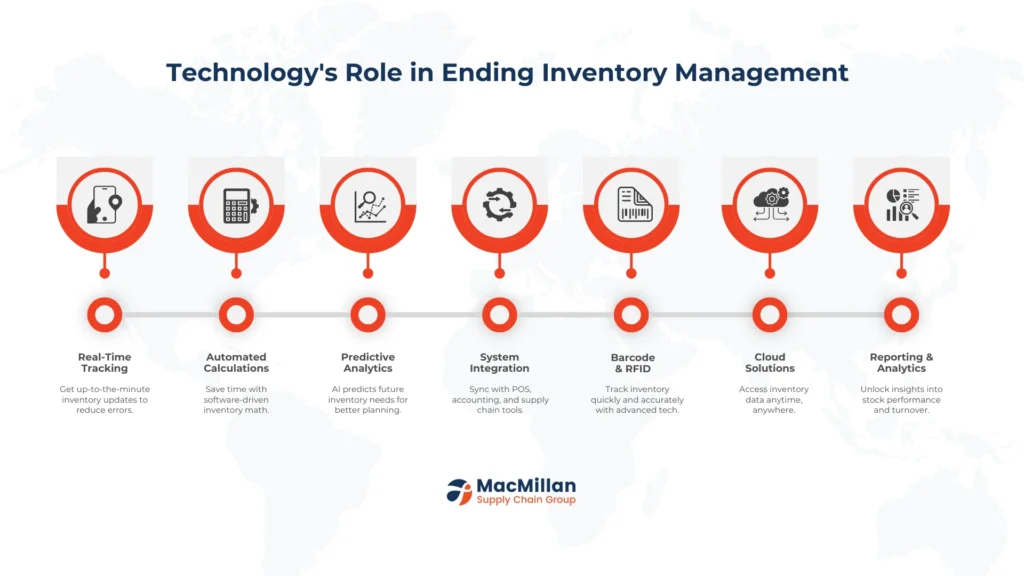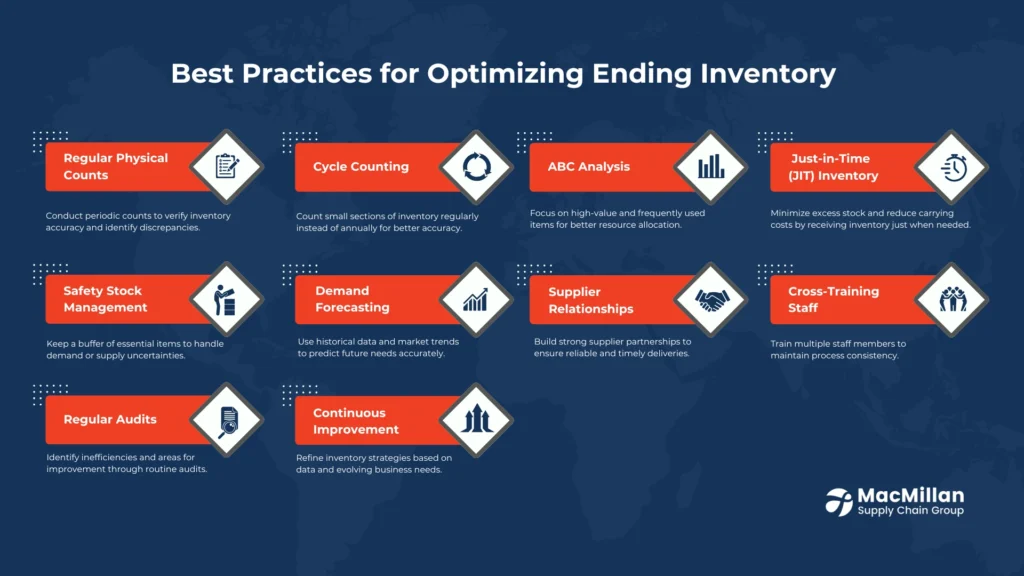A Quick Summary and Overview
Ending inventory is a crucial metric in supply chain management, representing the value of unsold goods at the end of an accounting period. Accurate calculation and optimization of ending inventory are essential for financial reporting, operational efficiency, and strategic decision-making. This comprehensive guide explores the methods for calculating ending inventory, its importance in business operations, and strategies for optimization. We’ll delve into common challenges faced by businesses and provide expert solutions to enhance your inventory management. By mastering ending inventory, you’ll be well-equipped to streamline your supply chain, improve financial accuracy, and drive business growth.
Introduction
In the dynamic world of supply chain management, understanding and optimizing ending inventory is a game-changer. As the final piece of the inventory puzzle, it plays a pivotal role in financial reporting, operational planning, and overall business strategy. But what exactly is ending inventory, and why is it so crucial?
Ending inventory represents the monetary value of goods remaining unsold at the conclusion of an accounting period. It’s a key component of your balance sheet and directly impacts your company’s profitability calculations. Accurate ending inventory figures are essential for making informed decisions about purchasing, production, and sales strategies.
In this comprehensive guide, we’ll explore the intricacies of ending inventory, from calculation methods to optimization strategies. Whether you’re a seasoned supply chain professional or new to the field, this article will provide valuable insights to help you master ending inventory management and drive your business forward.
Understanding Ending Inventory and Its Importance
Ending inventory, also known as closing inventory, is more than just a number on a balance sheet. It’s a crucial indicator of your business’s financial health and operational efficiency. At its core, ending inventory represents the value of goods that remain unsold at the end of an accounting period, typically a month, quarter, or year.
The importance of accurate ending inventory calculations cannot be overstated. Here’s why:
- Financial Reporting: Ending inventory directly affects your cost of goods sold (COGS) and, consequently, your gross profit. Inaccurate figures can lead to misrepresented financial statements.
- Tax Implications: Over or underestimating ending inventory can impact your tax liabilities, potentially leading to compliance issues.
- Operational Efficiency: Knowing your ending inventory helps in planning future purchases, production schedules, and sales strategies.
- Performance Evaluation: It’s a key metric for evaluating the effectiveness of your inventory management practices.
- Cash Flow Management: Accurate ending inventory figures help in forecasting cash flow and managing working capital.
By maintaining precise ending inventory records, you’re not just fulfilling an accounting requirement – you’re gaining valuable insights that can drive strategic decisions and improve your overall supply chain performance.

Methods for Calculating Ending Inventory
There are several methods for calculating ending inventory, each with its own advantages and implications. The choice of method can significantly impact your financial statements and tax obligations. Here are the most common approaches:
- Physical Count Method: This involves manually counting every item in stock. While time-consuming, it’s the most accurate method and is often used for year-end reporting.
- Weighted Average Cost Method: This calculates the average cost of all inventory items available for sale during a period. It’s useful when individual item costs fluctuate frequently.
- First-In, First-Out (FIFO): This method assumes that the oldest inventory items are sold first. It’s ideal for businesses dealing with perishable goods or in inflationary markets.
- Last-In, First-Out (LIFO): This assumes the newest inventory items are sold first. It can lead to lower reported profits and tax savings in inflationary periods but is not allowed under International Financial Reporting Standards (IFRS).
- Retail Inventory Method: Often used by retailers, this method estimates ending inventory based on the cost-to-retail price ratio.
- Gross Profit Method: This estimates ending inventory using historical gross profit percentages. It’s less accurate but useful for interim reporting.
Choosing the right method depends on your business type, industry regulations, and specific operational needs. Consistency in applying your chosen method is crucial for accurate financial reporting and trend analysis.

The Role of Technology in Ending Inventory Management
In today’s digital age, technology plays a pivotal role in streamlining ending inventory management. Advanced inventory management systems and software solutions offer numerous benefits:
- Real-Time Tracking: Modern systems provide up-to-the-minute inventory data, reducing the need for frequent manual counts and minimizing discrepancies.
- Automated Calculations: Software can automatically calculate ending inventory using your preferred method, reducing human error and saving time.
- Predictive Analytics: AI-powered systems can analyze historical data to predict future inventory needs, helping optimize stock levels.
- Integration with Other Systems: Inventory software can integrate with point-of-sale systems, accounting software, and supply chain management tools for seamless data flow.
- Barcode and RFID Technology: These technologies enable quick and accurate inventory tracking, reducing counting errors and improving efficiency.
- Cloud-Based Solutions: Cloud systems allow for real-time access to inventory data from anywhere, facilitating better decision-making and collaboration.
- Reporting and Analytics: Advanced reporting tools provide insights into inventory turnover, stock performance, and other key metrics.
By leveraging technology, businesses can significantly improve the accuracy and efficiency of their ending inventory management. This not only saves time and reduces errors but also provides valuable insights for strategic decision-making.

Best Practices for Optimizing Ending Inventory
Optimizing your ending inventory is crucial for maintaining financial health and operational efficiency. Here are some best practices to consider:
- Regular Physical Counts: Conduct periodic physical inventory counts to verify accuracy and identify discrepancies.
- Cycle Counting: Implement a cycle counting program where a portion of inventory is counted regularly, rather than all at once annually.
- ABC Analysis: Categorize inventory items based on their value and frequency of use to focus attention on high-value items.
- Just-in-Time (JIT) Inventory: Adopt JIT principles to minimize excess inventory and reduce carrying costs.
- Safety Stock Management: Maintain appropriate safety stock levels to buffer against uncertainties in demand and supply.
- Demand Forecasting: Use historical data and market trends to accurately forecast demand and adjust inventory levels accordingly.
- Supplier Relationship Management: Develop strong relationships with suppliers to ensure reliable and timely deliveries.
- Cross-Training Staff: Ensure multiple team members are trained in inventory management processes to maintain consistency.
- Regular Audits: Conduct regular audits of your inventory management processes to identify areas for improvement.
- Continuous Improvement: Regularly review and refine your inventory management strategies based on performance data and changing business needs.
By implementing these best practices, you can optimize your ending inventory levels, reduce carrying costs, and improve overall supply chain efficiency.
Common Problems with Ending Inventory and Our Solutions
Despite its importance, many businesses struggle with accurate ending inventory management. Here are some common problems and how MacMillan Supply Chain Group can help solve them:
Inaccurate Physical Counts:
Problem: Manual counting is prone to human error, leading to discrepancies between reported and actual inventory levels.
Solution: MacMillan implements advanced barcode and RFID systems, coupled with mobile scanning devices, to ensure accurate and efficient physical counts. Our team also trains your staff in best practices for inventory counting.
Inconsistent Calculation Methods:
Problem: Switching between different calculation methods or inconsistent application can lead to inaccurate financial reporting.
Solution: We help you choose the most appropriate calculation method for your business and ensure its consistent application. Our customized inventory management systems automate calculations, reducing errors and ensuring consistency.
Poor Demand Forecasting:
Problem: Inaccurate demand forecasts can lead to overstocking or stockouts, impacting ending inventory levels.
Solution: MacMillan utilizes advanced predictive analytics and machine learning algorithms to improve demand forecasting accuracy. We analyze historical data, market trends, and external factors to help you maintain optimal inventory levels.
Lack of Real-Time Visibility:
Problem: Outdated inventory data can lead to poor decision-making and inefficiencies.
Solution: We implement cloud-based inventory management systems that provide real-time visibility into your inventory levels across all locations. This enables better decision-making and more efficient operations.
Inefficient Warehouse Management:
Problem: Poor warehouse organization can lead to lost or damaged inventory, affecting ending inventory accuracy.
Solution: MacMillan offers comprehensive warehouse optimization services, including layout design, process improvement, and implementation of warehouse management systems (WMS) to enhance inventory accuracy and efficiency.
Inadequate Inventory Valuation:
Problem: Incorrect valuation methods can lead to inaccurate financial reporting and tax issues.
Solution: Our team of experts helps you choose and implement the most appropriate inventory valuation method for your business, ensuring compliance with accounting standards and tax regulations.
Lack of Integration Between Systems:
Problem: Siloed systems can lead to data discrepancies and inefficiencies.
Solution: MacMillan specializes in integrating inventory management systems with other business applications like ERP, accounting software, and e-commerce platforms, ensuring seamless data flow and improved accuracy.
Seasonal Fluctuations:
Problem: Businesses with seasonal demand often struggle to manage inventory effectively throughout the year.
Solution: We develop customized inventory strategies that account for seasonal fluctuations, helping you optimize stock levels and cash flow year-round.
By partnering with MacMillan Supply Chain Group, you gain access to cutting-edge technology, industry expertise, and tailored solutions that address these common challenges, ultimately optimizing your ending inventory management and boosting your supply chain efficiency.
How Can Readers Avoid Problems or Implement Solutions
To avoid common ending inventory problems and implement effective solutions, consider the following steps:
- Assess your current inventory management processes to identify areas for improvement.
- Invest in modern inventory management technology that suits your business needs.
- Train your staff in best practices for inventory counting and management.
- Regularly review and update your demand forecasting methods.
- Implement a cycle counting program to maintain inventory accuracy throughout the year.
- Ensure consistency in your inventory valuation and calculation methods.
- Integrate your inventory management system with other business applications for seamless data flow.
- Regularly audit your inventory processes and make continuous improvements.
While these steps can significantly improve your ending inventory management, implementing them effectively can be challenging without expert guidance. That’s where MacMillan Supply Chain Group comes in.
Our team of supply chain experts can provide you with tailored solutions to optimize your ending inventory management. From implementing cutting-edge technology to developing customized strategies, we’re here to help you overcome challenges and drive your business forward.
Don’t let inventory issues hold your business back. Contact MacMillan Supply Chain Group today for a free consultation. Let us help you transform your inventory management processes and boost your supply chain efficiency. Visit our website or call us to get started on your journey to inventory optimization.
FAQs
A perpetual system continuously updates inventory records with each sale or purchase, while a periodic system updates inventory at set intervals. MacMillan can help you choose and implement the system that best fits your business needs.
The frequency depends on your business type and size. Generally, annual counts are common, but cycle counting throughout the year is often more effective. MacMillan can help design a counting strategy that optimizes accuracy without disrupting operations.
Ending inventory directly affects the balance sheet and income statement. It's an asset on the balance sheet and influences the cost of goods sold on the income statement. MacMillan ensures accurate inventory valuation for reliable financial reporting.
Implement just-in-time inventory practices, improve demand forecasting, and optimize reorder points. MacMillan's advanced analytics tools can help you strike the right balance.
Methods like FIFO, LIFO, and weighted average can have different tax implications. MacMillan's experts can guide you on the most tax-efficient method for your business while ensuring compliance.
Strategies include better demand forecasting, optimizing product mix, and improving supply chain efficiency. MacMillan offers comprehensive solutions to enhance your inventory turnover.
Safety stock acts as a buffer against uncertainties. MacMillan can help you calculate optimal safety stock levels to balance customer service and carrying costs.
These items should be written down or written off, impacting your ending inventory value. MacMillan can guide you through this process and implement strategies to minimize obsolescence.
While consistency is important, different product categories might benefit from different methods. MacMillan can help you develop a comprehensive inventory valuation strategy.
In dropshipping, you typically don't hold inventory, simplifying calculations. However, accurate record-keeping is still crucial. MacMillan can help set up systems to track dropshipped items effectively.
By addressing these common questions and leveraging MacMillan's expertise, you can significantly enhance your ending inventory management, leading to improved financial accuracy and operational efficiency.WW
